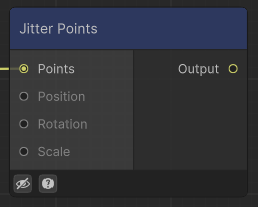
Modifies the points according to the fields assigned.
- Position: Should be a height map with the distance in world units
- Rotation: Should be a height map with the rotation value in Degrees. (Aka a height map that goes from 0 to 360 would rotate to all directions)
- Scale: Should be a density map from 0 to 1. A higher or smaller value can be introduced, but it’s important to take that into account when using nodes like Flatten Around or Points to Height since their size might overflow the defined bounding size.
Examples
Desert Pyramids
Recipe
Notes
To place different pyramid-like structures, we start by creating a grid of points and randomly positioning them. We use the Jitter Points Node to randomize their position, rotation, and scale.
At each of these points, we create a pyramid using the Shape Node and spawn it with the Points To Height Node. By ticking the required boxes, we ensure that the sampled shape follows the points data correctly.
Next, we apply some stepping to the pyramids to add texture, making them look more like layered cubes.
We then combine the pyramids with basic noise to give them a less uniform look, as though there’s sand on top of each layer.
Finally, we blend these pyramids with some Simplex Noise to achieve the final terrain.

Node system

Result